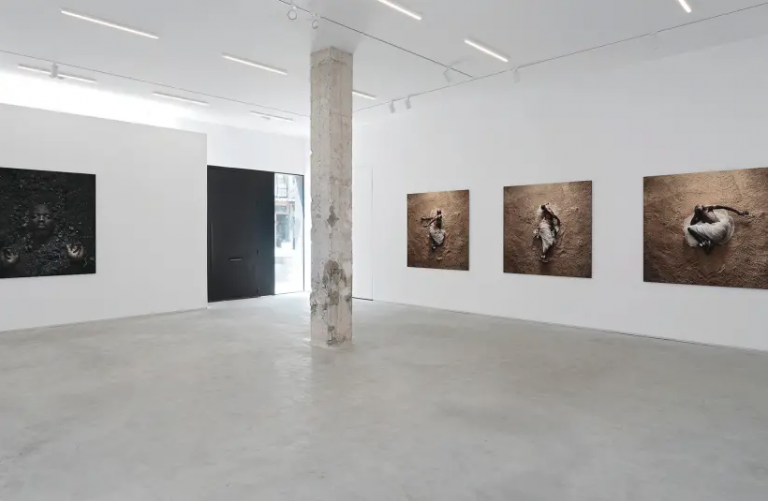Modikaseng’s inspiration is often drawn from dreams, from baffling scenes or stunning images projected by his mind’s eye.
By Ori J. Lenkinski
Have you ever woken from a dream with an image you don’t completely recognize in your mind? Some remnant of that dream, spilling over into your woken consciousness? Often, dreams present us with distortions of our own realities, with samplings of distant memories or fantasies of an unrealistic future. These images are often more beguiling and confusing than anything we might find in our day to day.
For artist Mohau Modikaseng, these moments are the keys to creation. His inspiration is often drawn from dreams, from baffling scenes or stunning images projected by his mind’s eye. “I have persistent dreams; the same images come to me in dreams over and over,” he said in a recent interview with The Jerusalem Post. Modikaseng, 33, spoke via WhatsApp, as cellphone signals were weak where he resides in Johannesburg.
Born and raised in Soweto, Modikaseng’s entrance into the art world happened gradually. “My father worked at a high school in Soweto. He would walk around when the school was closed and collect pens, so I always had something to draw with,” he remembered. “Whenever we had to do diagrams, my teachers would point out that mine were well done. I saw that there was a skill and my parents could support it. In 2004, I got a chance to travel to London with fellow students from Soweto. We visited museums and I went to my first art shop.”
Not long after, Modikaseng enrolled in the University of Cape Town. He continued his studies at Wits University in Johannesburg. He completed his master’s in 2012 and has been showing internationally since. In 2017, his series Passage was featured in the South African Pavilion of the Venice Biennale.
He usually splits time between his family home in Johannesburg and his studio in Cape Town, however, COVID-19 has kept him in Johannesburg for over five months. His work is currently being exhibited at the Braverman Gallery in Tel Aviv; a show he would be present for had it not been for the travel restrictions in place.
In his current show, which is a curated introduction to Modikaseng’s work for Israeli audiences, there are both photographs and videos, many of which began as dreams.
“I see an image in a dream and then I sketch it out. I then spend a couple months living with that image, researching where it comes from. Then I’ll start testing it out and decide how best to refine it. Eventually, I’ll hire the equipment I need and shoot it. That process can take a long time, the longest, which was the ‘Passage Project,’ took about two years from that first image to showing,” he explained.
This work employs both photography and video. “It started as a very elaborate concept. I was asked to do a lineup for the opening of a museum in Cape Town. There is a dried-up dock there, it’s one of the oldest in southern Africa. I wanted to shoot this dry dock filling up with water. I decided instead of using the structure of the dry dock, I used a boat. In the ‘Passage Project,’ the boat is filling up with water. In that time I was dreaming and having conversations, all with coincidental mentions of water. It’s like everything was connecting.”
His images evoke conflicts surrounding controversial voyages both current and historic. These associations are at the heart of each creation. “Most of the time the work is in response to some kind of social phenomenon. With the commission from the South African Pavilion, they gave a brief and wanted me to concentrate on hidden histories. My research took me back to 1652 and Dutch colonists landing in the Cape of Good Hope. They created a colony. There, the history of the migration of black people began to happen. My research led me to the movement of black bodies. And I wanted to look at displacement. And you can’t look at that without arriving at the Transatlantic slave trade. There’s a historical link between that journey and the African migrants. I wanted to put as much into this work, as many references as I could.”
In all of Modikaseng’s works, there is a strong sense of movement. In Passage 6, a suit-clad man lays into the water flooding his white boat. In Untitled (Zanj 3), a topless man twists into the sand beneath him, and in Zion 2, a woman in white is captured holding to large drum in mid-spin. Though he is not a trained dancer, movement is a vital element in Modikaseng’s work. “There’s an intuitive reading of how the body creates meaning through movement. Choreography has become a key in my work,” he said.
And though he cannot attend his show in Israel, Modikaseng plans to visit at some point in the future.

Sunday
Monday
Tue – Thu
Friday
Saturday
Closed
By appointment only
11:00 – 18:00
11:00 – 14:00
11:00 – 14:00
Design by The-Studio
Code By Haker Design